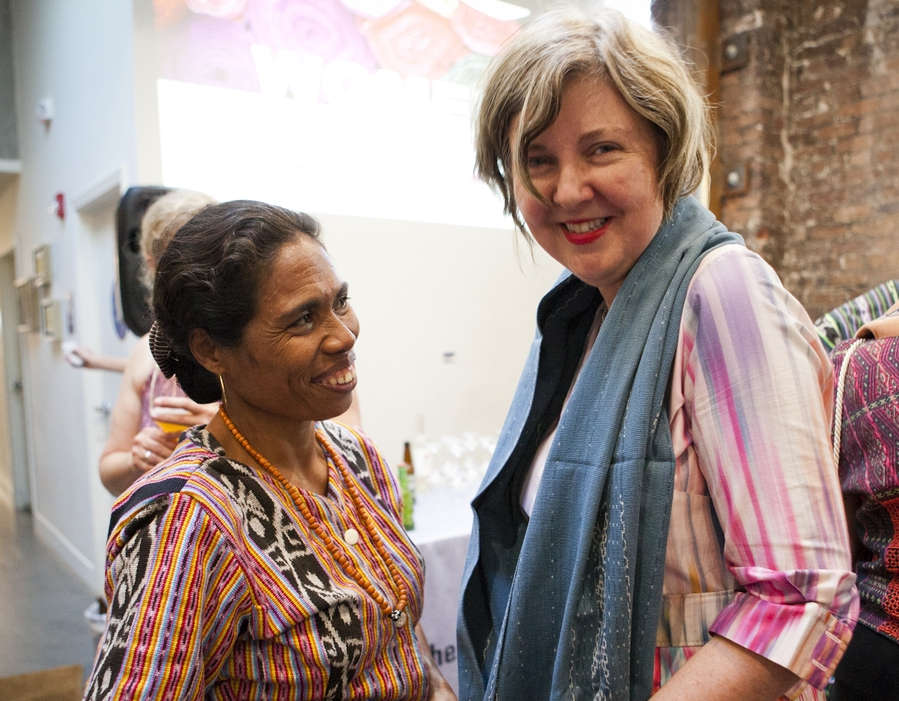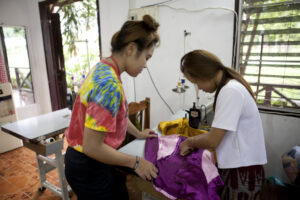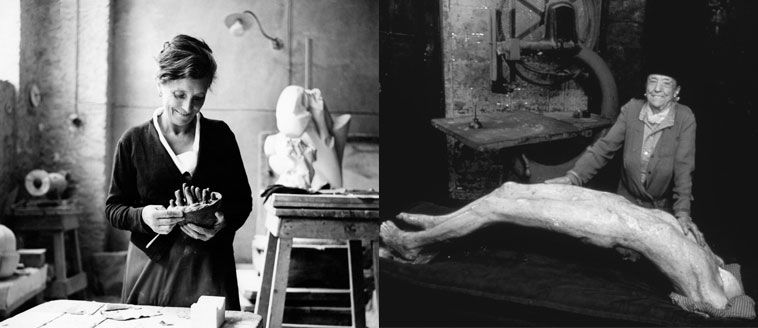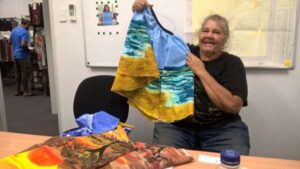
I recently travelled to Laos to join The Asia Foundation’s country representative there, Nancy Kim, to visit local women artisans and some of the other work supported by the foundation. My colleague and filmmaker, Whitney, accompanied me to capture the stories and voices of the women we visited.
When we arrived in the villages near Savannakhet, the women brought out reams of exquisitely textured fabrics that had been created by women in their villages. We were supporting some of these women to participate in the Santa Fe International Folk Art Market this year. We heard from these artisans that this opportunity would allow them to keep their daughters in school this year, and that increased economic security would likely provide greater protection from trafficking.
If sales and buyer connections went well, the flow on benefits would provide more work opportunities for young women from their villages, so that they are not forced to go to Thailand to do low-wage work. This opportunity would then contribute to the renaissance of artisan power in Laos and their outreach to the world.
Two of the women in the villages we visited in Laos shared their stories.
This is Tui’s story.

Our village has continued the same tradition for generations…we know how to do natural coloring of fabric as it’s our tradition. In the past, our village’s main job was rice farming. But during the dry season, women weaved, made blankets and mattresses for families, and took care of children.
I started weaving in 2000 and organized our weaving group. Everyone did their own weaving – if that person had finished two, I bought two, if another had five, then I bought five.
Some local community people knew how to produce weavings, but they did not have a market to sell their products and had no idea how to sell. Therefore, I buy their products at a reasonable price, and then find markets to sell. Then women have work to do and increase their income to support families.
The way of our practice is, everyone has different knowledges. I give everyone chances, if they had, I bought, we discussed and agreed. I’m also proud to see them have work to do and gain some income. I can sell our products because the price is reasonable. We really focus on quality. With customers, we always tell them that our products are made with real natural color.
Our community has changed (since I started weaving). Many women can earn income, women are stronger and have equal rights to men because women can earn money almost every day. It was different in the past. After finishing rice farming, women took care of children and waited to use money given by husbands. Today, women are stronger, a woman can earn money and that makes me proud to see women and our community gain more income.
In the past, men were always presented in the front of families while women were always behind. Now, family in our village has been reorganized. In some families, men support their wives to produce materials, they could make color for example, they become wife’s assistants and they are also proud of their wives. And our women get more respect.
I buy almost all products from local people. Like what you saw over there. Then I must find markets to buy those products. I usually send to market every three days. Some orders 50 and some orders 100 pieces; and some may order up to 200 pieces. I buy every day from the weavers, by this person and that person, depending on if they have products. I sometimes owed them because market did not pay me and I had no money to pay; but not more than one or two days so I had to inform them that tomorrow they could come to get money, and they came back.
I am so proud that our products will be known by the world and reach America. That will give us income and other benefits. I would also like to encourage some of our young people working in Thailand to come back and work in our community when we are strong enough. I hope young women will return to the community to work here, produce traditional materials, making nature colors, planting and doing anything here. Many young women have left our village to work in Thailand at low pay.
My expectation is that in 10 years I would like to see the change of women and they have better livelihoods. I will be proud to see that happened and my family business will increase too in the future.
One of the other women we met, Lae, also shared her story.

I’m proud to be able to do weaving. In the past, my parents taught me how to do weaving and I like doing it.
I started weaving in 2000 when I was about 16. I also helped my parents doing farming as it was the only job in the community. I finished only secondary grade 2 at school. When I saw my mother gained income through weaving I followed her as her assistant. After a while my mother stopped working, so I continued working. I started looking for customers until my village organized the weaving group. I applied, and have worked together with Mrs. Tui doing weaving and my own design.
There are about 10 women the same age as me that weave. Some of them also continue study. But most of them are just weaving. Some of them who left school went to work in Thailand in a factory.
If there are more markets, it would be good for us and it will help our community to have more work and people will have more income to support their family. I’m very happy and proud to have a chance to go to Santa Fe. Of course, I have a lot of hopes. I expect to have more customers and more orders of our product; that would help to develop our village. I would like to thank Facebook and WhatsApp as they make me fast in trade and communication, comfortable and easy in conversation. When buyers need products, they can send the order. It’s easy and I’m happy.
My husband is happy with me. I married him in 1999. Since we married, he never disagreed that I work on weaving and it helps to increase family income, although my husband does not help me because we have divided our tasks: husband does farming and raise the cows, and I do weaving. But we discuss and support each other.
I hope that in the future, our work will be bigger. I expect we can sell more, especially through export. I would like to do better than this and to have more customers. But we have come a long way. When I started with my mother, we had no technology. It was very difficult for communication and transportation. If we needed something, we used letters and or communicated through public transportation like bus. The bus could service us only once per week, but some work requested was urgent. Then we used radio to help communicate. Travel was also very difficult because of the quality of the roads. if it rained, we had to take tractor to help transport us to the main road to catch the bus. It was very difficult at that time, however, it’s comfortable now.

While in Laos, we also visited the Laos Women’s Shelter, led by visionary director, Madame Virith Khattignavong. The Asia Foundation was instrumental in helping to create the shelter and supporting its early work. The shelter is located on a large tract of land, which was provided by the government on long-term lease, surrounded by gardens and market produce. The shelter takes in girls and young women who have been affected by violence, and it provides them with access to formal education and apprenticeships in hairdressing, hospitality, textiles, and horticulture.
The girls and young women go to school each day and return to the shelter as their home and community. For those young women who want to gain livelihood skills, they can learn these skills within the shelter grounds. The shelter has also have developed a network of employers who employ the girls and women who have completed their studies or apprenticeships. This integrated approach ensures that there are sustainable livelihood opportunities for girls and young women who arrive at the shelter, providing increased freedom from violence and pathways to prosperity. Others can access scholarships and continue their study at college or university.

The grounds themselves are lush and spacious and we visit a community garden planted out with vegetables and fruit and herbs that are abundant and inviting. The gardens are well tended and provide an important outlet for the girls and young women to learn about nutrition while also testing their skills as cooks and horticulturalists.
I listen to some of the young women talking and laughing, then we visit one of the training areas where it is very quiet as these women concentrate on their work, and from time to time glance over at us. I’m as curious as the young women, and I’m struck by the quality of their work and their composure.
What’s essential in this work is supporting girls and women to be safe and free from violence and connecting them to pathways to education and employment so that they have the economic security to pursue their potential and passions. I think back to the women artisans we met and to the real joy they expressed in their art and work.
While in Laos, I also had time to discuss with Nancy the potential of creating an artisan market in Asia, drawing on the success of the Santa Fe International Folk Art Market that has been going for 14 years and which attracts more than 20,000 buyers each year. What if we could create the opportunity for a similar market in Asia that would provide women artisans in Asia the opportunity to be connected to more buyers and markets, and to build year-round sustainability of their products? That is some of what we’re exploring at present in our discussions with buyers and artisans.
Several of my colleagues traveled to Santa Fe to join the women artisans from Laos, Bangladesh and Timor Leste whom we’d funded to be able to participate in this market. My colleague, Whitney, was also there to capture on film the journey these women had made and their experience of the market and the outcomes for these artisans.
I couldn’t be there as I was flying to London to take up a non-residential Atlantic Fellowship with the Inequalities Institute at London School of Economics. This fellowship is one of several across the globe funded by The Atlantic Philanthropies and is designed to support a corp of global practitioners working to address inequality in its many forms over a 20-year period. I’ll be sharing more about this experience in future blogs and this program inception was a powerful start to develop our thinking and action in relation to the inequalities we were focused on through our own work, for me most especially gender equality.
 While I was in London I went to the Tate Modern and picked up one of the books written by Louise Bourgeois – one of the most provocative, creative and arresting sculptors and textile artists of this century. It was Bourgeois who said “Art is restoration: the idea is to repair the damages that are inflicted in life, to make something that is fragmented – which is what fear and anxiety do to a person – into something whole.”
While I was in London I went to the Tate Modern and picked up one of the books written by Louise Bourgeois – one of the most provocative, creative and arresting sculptors and textile artists of this century. It was Bourgeois who said “Art is restoration: the idea is to repair the damages that are inflicted in life, to make something that is fragmented – which is what fear and anxiety do to a person – into something whole.”
She also said “I am not what I am, I am what I do with my hands…” This resonated with me since it had been a few months since I’d taken time to draw, paint and dance. It was a reminder of not subsuming work and other commitments to the creative impulse to express and explore. There’s beauty and fire in taking up that invitation to enter another dimension by dancing, sculpting, painting, writing, filming and other creative forms.
After two weeks in London I was finally back on my boat. What joy!
A day later we held an event and pop-up shop in San Francisco for the artisan entrepreneurs who had traveled from Bangladesh, Laos and Timor Leste to Santa Fe so that we could welcome them to the Bay Area before they returned to their respective countries.
The color and energy these women brought with them through their textiles was contagious. The event we hosted was a riot of color and activity as guests exclaimed over the quality of the textiles and tapestries, and then went into a buying frenzy to purchase some of the gorgeous garments and crafts the artisans had for sale.
A year ago, this was just a dream. To find ways to get some women to the Santa Fe event, to explore a sister event in Asia and find donors to help make this a reality. Now it feels like we’re on our way.
On the other side of the world, in Darwin, Australia, enroute from Timor Leste to Sydney via Darwin, I recently interviewed a group of Aboriginal and Torres Strait Islander women textile artists about their own work and art for an article in AQ: Australian Quarterly magazine. One of my friends, and a great Australian leader, Lenore Dembski, who created the Aboriginal and Torres Strait Islander women’s fund (ATSI women’s fund) brought these women together at Paperbark Woman, her Darwin based outlet to showcase these textiles.

One of the women, June Mills, is a musician and a member of the famed Mills Sisters group, as well as a gifted artist.Here’s what she said, as an excerpt from the interview when I asked her to share more about what painting her dreaming on clothing and creating other art meant to her:
June: It’s cultural maintenance, cultural knowledge. You know, we’re in a dominant culture, which suppresses our cultural business, so there was a definite need for me to make clothing that is representative of our culture, our tribal people.
That skirt of mine that I made, that you fell in love with, is the major Dreaming for the Larrakia people… And you’ll see the sea eagle, another major Dreaming. The sea eagle flying over Casuarina Beach. So that, to me — calling up our Dreaming — is giving our children strength in the knowledge of whom they are, their identity… With each generation, there’s less and less cultural knowledge and all being passed on. And so we really have to fight against that, push against that. Assimilation and integration is still going on in this country … to make us like every other Joe Blow. Well, no, we’re not. We are people of the land and that’s what my art is about.
Jane [interviewer]: June, do you see a connection between your music and your art?
June: Well, my friends here are saying it’s all about making yourself happy. I was thinking about [how] for a long time with my sisters we just sang [as the Mills Sisters] what everyone else wanted us to sing… But then, at some point, I started to make my own music that had much more cultural relevance to me… My music is very much a mixture of cultural business, healing business and fun business… One of the things I did as healing business was I wrote a song for my grandmother who was taken away from her country when she was only three years old and taken to Warrnambool to be a slave there — until she was too old and then she was sent back to the territory. But there was no record of where she came from, or of her family — nothing.
Miraculously, she found her way back to country because she remembered one word. And that word was her birth name, Kilngaree. She had her name changed five times and yet she remembered her birth name. She sung her way back here before she died… So I wrote that song, ’Sweet Child of Mine’, which has in it the line, ‘remember your name’. But that name… Kilngaree, means ‘a stream system’ in Larrakia, and so Kilngaree took my nanna right back to her birthplace. She had to ask around and people knew the language and said, ‘This way’. I finally found my own voice and I wouldn’t even say that it’s fully developed today.
The women speak about their need for support systems for these textile artists. Ideally an ATSI textile artist business incubator and manufacturing cooperative for women sewers and designers who can share facilities and lay out their work, and then a pop-up incubator in more rural and remote communities.

Another Aboriginal designer, Colleen Tighe-Johnson, whom I also interviewed for Australian Quarterly has had invitations to New York Fashion Week and Cannes International Film Festival. In the article she said, “Our people are hurting; our people are dying. They need the connection to community and economic opportunity that will give them hope and focus.”
Colleen also dreams of creating a similar cooperative in Redfern in Sydney to provide pathways to urban Aboriginal and Torres Strait Islander women to be supported in developing their skills, designs and access to markets.
My own struggle and question, from the time I spend with the women in Laos and the time spent with Aboriginal and Torres Strait Islander women artists, is how to connect these women to the funds and power they need to transform their lives.
Individual and institutional donors have so much money. The world is awash with money. And yet so much of it bypasses those who have demonstrated time and time again the potency of their own work and potential to catalyze change in their countries and communities. As donors seek to aggregate their funding to reduce administrative costs, those at the frontline of change within their communities get left out.
The renewed focus and fascination with innovation frequently rewards those who are already well placed and positioned to receive the funding, further widening the divide with those on the margins.
We need a genuine commitment to funding grass roots groups, especially those led by women, and to ensuring they are included in policy forums and key places of influence – where their work on the ground can influence policies and laws and ensure an enabling environment for their work and creativity.
Funding these groups is important and yet inadequate if this funding isn’t combined with a commitment to support women leaders to assume power and influence in policy and legislative decision making and arenas. Without paying attention to the policy and legal factors that create an enabling environment as well as the social norms that sustain inequality, there’s a danger of ‘spinning wheels’ – i.e. getting the funds to groups without addressing the systemic and attitudinal factors that inhibit transformation.
[symple_testimonial by=”Diane Mariechild” fade_in=”false”]A woman is the full circle. Within her is the power to create, nurture and transform.”[/symple_testimonial]
 Back in Sausalito there’s a buttery yellow moon slung low over the water. I’m back again! So now, full circle, I return to the flowing tide of my boat life to draw from the energy and power of nature’s rhythms, and the sweet beauty of home.
Back in Sausalito there’s a buttery yellow moon slung low over the water. I’m back again! So now, full circle, I return to the flowing tide of my boat life to draw from the energy and power of nature’s rhythms, and the sweet beauty of home.
Jane Sloane
Sausalito